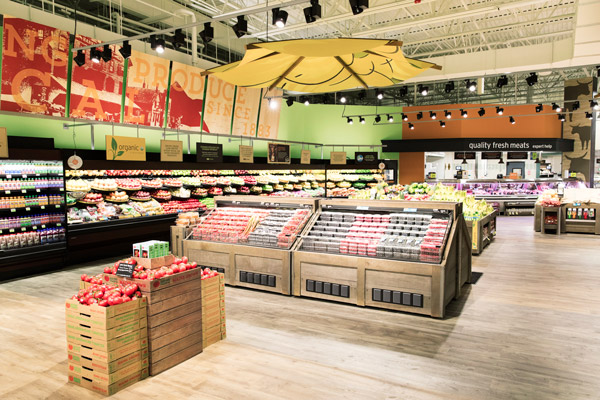
As a fresh fruit and vegetable vendor on Portland, Maine’s waterfront in 1883, Arthur Hannaford was fastidious about the high quality of his wares. And even as his business grew from cart to wholesaler to retailer to the chain of grocery stores now known as Hannaford Supermarkets, those high standards never changed. No matter what, any revision of the core business would have to meet or beat the high quality of all the company’s past efforts.
So, in 2012, when Ben LaBelle, Hannaford’s director of construction, design, and retail projects, was tapped to design and manage the creation of prototypes for taking Hannaford’s stores in a new direction, he was facing a daunting task: improve on supermarkets that had themselves been designed to Hannaford’s high standards and had succeeded in the marketplace. But LaBelle had some personal insight into the importance of quality to a grocery store’s customers that he brought to the challenge.
As a teenager, LaBelle worked at a local grocery store, first as a stock person, then as a meat cutter, a role that taught him an important lesson. “I realized that an improper cut would give the customer a horrible dining experience, but if the cut was crafted to enhance the best quality of the meat, the customer came back.” LaBelle had connected his work directly to the success of the business, and he’s been applying that simple lesson to his efforts ever since.
LaBelle stepped into his role after the company had opted to integrate its construction, design, capital management, and retail projects departments into a single unit. He and his multifunctional team spent two years crafting a new design concept. Exhaustive market research revealed not just emerging trends but also the reasons for those trends, and LaBelle and his team modified their designs accordingly.
The new design also reflected the two main categories of customers: those who want convenient, ready-to-eat meals; and dedicated home cooks who have their meals planned for the week. The “I want to eat now” shoppers are picking up that night’s dinner, so the self-serve and kitchen elements (featuring a hot grill for stir fry and other offerings) are there as patrons walk through the store’s main entrance. The associates in these sections are trained to engage their customers, offering tips and noting sales, while the physical presence of each area acts as their theater, ensuring that customers get great food in an entertaining environment. In contrast, the “I’m creating next week’s menu” customer spends more time shopping the aisles on the left side of the store.

An overarching challenge for LaBelle was to present Hannaford’s emphasis on high-quality products in physical form. One way of doing so is Hannaford’s “Healthy for Life” concept, which added a consultation room where pharmacists can confidentially provide medication management services. Sustainable, locally sourced food is also a hallmark of the chain, so shoppers find products produced nearby on the shelves. A registered dietitian is also available to educate and advise customers.
To help manage the challenges of the redesign process, LaBelle worked to focus his team closely on their shared goal. He instituted regular meetings of the multifunctional team. These meetings allowed his team members to gain a deeper understanding of their roles in the process and to see how their decisions would affect the group as a whole. As a result, the various sectors of the team realigned their processes into a single playbook to which each would contribute and for which all were accountable. “Ultimately, it didn’t matter which folks were talking. They were all telling the same story, and they all understood what the business needs were,” says LaBelle.
LaBelle and his team’s efforts paid off. A small store format (20,000-square feet, and designed for smaller towns) opened in North Berwick, Maine, in 2015, and a large store format (50,000-plus-square feet) opened in Bedford, New Hampshire, in 2016. The response to each has exceeded expectations. Sales are up, and the company is bringing what it learned from these prototypes to other stores as it remodels existing supermarkets and builds new ones.
“We use technology to keep inventory and labor costs down and help us embrace innovations in design and constructions as we go along. When we approach projects in alignment, we can work through and achieve every opportunity,” LaBelle says. It seems like Hannaford’s will continue leading its industry for another 134 years.
Photos: Brian Fitzgerald, Kevin Brusie


